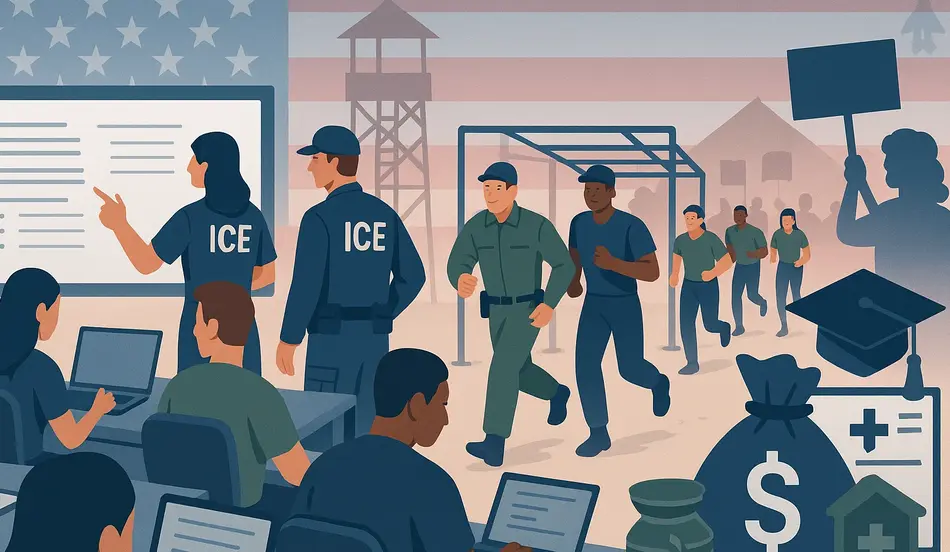At first glance, the obstacle course looks like something out of a military boot camp. Recruits sprint over hurdles, crawl under barriers, and scale wooden walls, all while instructors bark orders and clock their time. Beyond the obstacle course, the sounds of gunfire echo from the shooting range, where trainees practice with pistols and rifles under the watchful eyes of firearms instructors.
This is not the Army or the Marines. This is Immigration and Customs Enforcement (ICE), the U.S. agency tasked with enforcing immigration laws, protecting national security, and dismantling cross-border criminal organizations. And ICE wants Americans to know it is hiring.
The agency has launched one of the largest recruitment drives in its history, hoping to attract thousands of new agents at a time when immigration enforcement is under the national spotlight.
A Surge in Applicants
According to ICE officials, the agency has received more than 100,000 applications since the start of the Trump administration, a figure they say demonstrates strong interest despite the controversies surrounding the agency.
Acting ICE Director Todd Lyons, who has spent over 20 years in the agency, says the effort is essential.
“We’re really working hard to recruit new agents. It’s a great position, and the tide is turning,” Lyons told Fox News during a recent media visit. “The American public is really seeing what we do for the community.”
One of the reasons for the surge is a combination of incentives and lowered entry barriers. ICE recently announced a $50,000 signing bonus for qualified recruits. The agency also dropped its minimum age requirement, hoping to attract younger applicants. Roughly four in ten applicants come from military or law enforcement backgrounds, a pool of candidates that ICE believes provides discipline and real-world readiness.
Inside the Georgia Training Center
ICE’s Georgia training center is where recruits transform from civilians into federal agents. The facility combines physical endurance training, classroom learning, and firearms drills.
On the obstacle course, candidates must show agility, strength, and composure under pressure. They run through mud, climb over fences, and maneuver heavy equipment – all tasks meant to simulate the challenges of field operations.
The gun range is another critical component. Recruits fire handguns and rifles, learning the precision and discipline required of federal officers. For many, it’s the first time handling weapons at such intensity. For veterans or former police officers, it’s a return to familiar territory.
The program also includes scenario-based exercises, such as practicing arrests, securing vehicles, and clearing buildings. Trainees are constantly monitored for decision-making skills and emotional control. Mistakes are corrected immediately, as instructors remind them that hesitation or poor judgment in the field could cost lives.
“These tools are how our designs become a reality,” one instructor explained, gesturing toward the training setup. “Every hour, hundreds of recruits are being tested not just physically, but mentally.”
The Mission of ICE
ICE was created in 2003 as part of the Department of Homeland Security (DHS), following the September 11 attacks. It merged functions from the Immigration and Naturalization Service (INS) and the U.S. Customs Service.
Today, ICE’s responsibilities go far beyond border enforcement. Its two primary divisions are:
- Homeland Security Investigations (HSI): Targets transnational crimes such as drug trafficking, human smuggling, cybercrime, and terrorism financing.
- Enforcement and Removal Operations (ERO): Focuses on arresting and deporting individuals who violate U.S. immigration laws.
For supporters, ICE is a frontline defense against security threats. For critics, ICE represents the harsher side of U.S. immigration policy, accused of aggressive raids, family separations, and abuses.
Pushback and Public Perception
ICE’s recruitment drive has not gone unchallenged. In recent years, sanctuary cities and immigrant rights groups have loudly opposed ICE operations, arguing that the agency instills fear in immigrant communities and oversteps its authority.
Demonstrations calling for “Abolish ICE” became common during the late 2010s, and many local governments attempted to block ICE cooperation with local police.
Lyons acknowledged the criticism but insisted the mission is misunderstood.
“We get a lot of pushback, but our priority is safety,” he said. “What we do is protect the community. That message is resonating more now.”
ICE leaders believe public perception is shifting. Concerns about border security, drug smuggling, and fentanyl trafficking have fueled greater support for stricter enforcement measures. By showcasing their training and recruitment openly, ICE hopes to rebrand itself as a professional, disciplined agency focused on national safety rather than politics.
Why the Recruitment Now?
Several factors are driving ICE’s urgent hiring push:
- Increased Workload – Rising numbers of migrants at the U.S.–Mexico border have stretched enforcement operations.
- Retirements and Attrition – Many career agents are reaching retirement age, leaving gaps in the workforce.
- Political Pressure – The Trump administration has emphasized strong immigration enforcement as a core policy, raising expectations for ICE to deliver results.
- Expanding Mandates – Beyond immigration, ICE agents are increasingly involved in cyber investigations, financial crimes, and counterterrorism.
Recruiting young, tech-savvy, and physically capable agents is seen as essential to meeting these challenges.
Meet Urgent Hiring Needs
Post your job on WhatJobs and connect with young, skilled, and motivated candidates ready to take on critical roles in law enforcement, cyber, and national security.
Post a Job Now →What It Takes to Join
Applicants must pass rigorous background checks, including drug screening, polygraph exams, and psychological evaluations. Physical fitness tests are demanding, ensuring candidates can endure the stress of field operations.
At the Georgia training facility, instructors make it clear that not everyone will pass. Some recruits drop out voluntarily, unable to keep up with the physical demands. Others are disqualified for failing written exams or shooting accuracy tests.
Those who succeed emerge as sworn federal agents, carrying badges and firearms, ready for assignments across the country.
Controversy Over Incentives
The $50,000 signing bonus is one of the largest ever offered by a U.S. federal law enforcement agency. While it has drawn interest, critics argue it amounts to paying people to join a controversial mission. Some immigrant rights organizations say the bonuses could attract individuals more interested in money than public service.
ICE officials defend the move as necessary in a competitive job market where law enforcement agencies, private security firms, and even tech companies are all vying for disciplined, qualified recruits.
Broader Implications
The expansion of ICE’s workforce has implications beyond the agency itself. More agents could mean:
- Increased immigration raids in workplaces and communities.
- More deportations of undocumented immigrants.
- Greater investigative reach into financial and cyber crimes.
- Stronger federal presence in states with sanctuary policies.
For supporters, these steps mean stronger national security. For critics, they mean heightened fear among immigrant families.
Looking Ahead
The question remains whether ICE can sustain both the public support and the resources required for its massive recruitment program. While 100,000 applications sound promising, not all applicants will qualify. Training attrition rates can be high, and public controversies may deter some from signing on.
Still, ICE leadership insists the effort is worth it.
“We’re building the next generation of ICE agents,” Lyons said. “These are people committed to keeping America safe.”
As debates over immigration and enforcement continue into the 2026 midterm elections, ICE’s recruitment push is likely to remain a flashpoint in American politics.
FAQ: ICE’s Recruitment and Training
1. How many applications has ICE received recently?
ICE reports over 100,000 applications since the Trump administration began.
2. What incentives are offered to new recruits?
Recruits are eligible for a $50,000 signing bonus and the agency has lowered its minimum age requirement to broaden the applicant pool.
3. What kind of background do applicants usually have?
About 40% of applicants come from prior military or law enforcement service, providing experience in discipline and security.
4. What does ICE training involve?
Training includes physical obstacle courses, firearms practice, endurance drills, and scenario-based exercises that simulate real-world operations.




